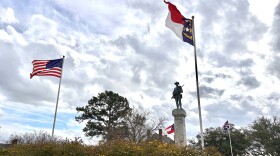Updated 1:20 p.m.
A North Carolina county where protesters tore down a Confederate monument proposed Tuesday to return the crumpled statue to public view inside a local government building, the latest effort in the state to deal with monuments that many decry as racist symbols.
A joint city-county government committee in Durham issued its recommendation for creating an indoor display at the county government building near the grounds where the statue was torn down in 2017. The county commission would have to approve the plan.
The proposal is the latest move in an ongoing debate about what to do with North Carolina's many Confederate monuments on public property. Another statue was torn down at the state's flagship public university in 2018, and Winston-Salem city officials recently called for a downtown statue there to be moved.
Durham's statue was torn down during a protest in reaction to a deadly white nationalist rally in Charlottesville, Virginia. To bring down the statue, one protester climbed a ladder to attach a rope while others on the ground yanked it down. Durham's Confederate Soldiers Monument, depicting an anonymous uniformed soldier leaning against his rifle, had stood since 1924 in front of a courthouse building that now holds local government offices.
Durham authorities initially sought to prosecute 12 people on charges of tearing down the statue, but none were convicted. A judge dismissed two of the cases and found a third defendant not guilty, and the prosecutor dropped charges against the others.
The proposal announced Tuesday calls for written passages about the statue's history to be part of an exhibit of the statue, which was bent and crumpled when it fell. The committee said displaying the statue in its current damaged form would add important context. The proposal would leave the statue's pedestal in place and add outdoor markers honoring Union soldiers and enslaved people.
The Durham proposal came a day after Winston-Salem held a city council meeting where residents spoke in favor of moving a Confederate statue out of downtown. The city recently sent a letter telling the United Daughters of the Confederacy to move the statue on the grounds of an old courthouse that's now privately owned or face legal action.
Meanwhile, the board that oversees the state's public university system is planning what to do with a Confederate statue torn down by protesters in 2018 at the University of North Carolina in Chapel Hill. Campus trustees had proposed spending $5 million to build a history center to house the statue indoors, but the plan was rejected late last year.
A 2015 North Carolina law on the preservation of Confederate statues on public land largely restricts what local governments and the UNC system can do with the monuments. The law prohibits moving the monuments except in very narrow circumstances.
The Durham committee said it consulted with legal experts and contends that the statue exists in a gray area because the law doesn't spell out what to do with damaged monuments.
North Carolina, Virginia and Georgia have the most statues on public land, according to the Southern Poverty Law Center. A state tally shows that around 50 of the North Carolina monuments are in front of contemporary or historic courthouses.








